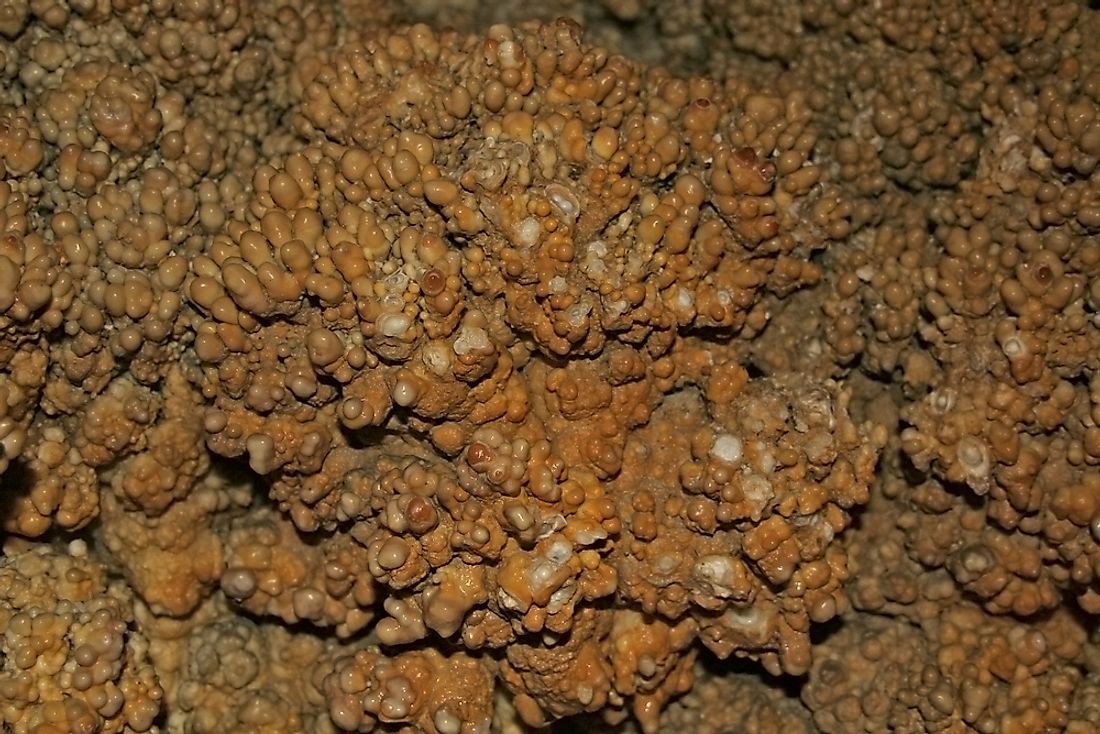What Is Cave Popcorn?

Cave popcorn is one of many types of speleothem or cave formations. In general, speleothem is formed from secondary deposits of minerals inside of a cave. Cave popcorn, also known as coralloids, is made of calcite, gypsum, or aragonite deposits. They are most commonly found in limestone caves.
Appearance
Coralloids take the form of tiny nodes or knobs and are often formed in clusters. The size of a single nodule can be between 0.5 to 2 centimetres. The nodes are usually white in colour but depending on the mineral composition the color can vary. They can grow on the bedrock or on the surface of other cave formations. Sometimes, needle like deposits of aragonite called frostwork may grow on cave popcorn forming a decorative pattern. Stratographic layers are formed when the coralloids end suddenly in a downward or upward direction. Cave trays are formed when the popcorn formation ends in a downward trend.
Formation of Cave Popcorn
Cave popcorn can be formed in two ways. The first type of formation occurs when there are water leaks out of a limestone wall in a uniform manner which deposits solid calcite on the surface of the cave. Formation occurs when water seeps from the ceiling or walls of the cave and splashes down on the floor or surface projecting from the walls of the cave. The splashing results in the loss of Carbon IV Oxide leaving deposits of calcite behind. The nodules formed from the precipitate resemble tiny flowstone balls. The second type of formation occurs though evaporation. The resultant coralloids are chalky in nature and are white, just like popcorn. The popcorns grow on the side of the cave that is in the direction of wind or air currents entering the cave.
Where Else Does Cave Popcorn Grow?
Apart from natural caves, coralloids can also grow on manmade structures. The most common is on concrete buildings, and this type of formation is called calthemite. They can also form in mining caves, road tunnels, or railway tunnels. The cement in the mortar of concrete is the source of limestone and dissolved calcium ions are leached out and carried to the surface of the concrete. When the water carrying these ions evaporates, calcium carbonate is deposited on the concrete surface forming tiny chalky coralloids which resemble cauliflower. The projection length of the calthemite popcorn varies with some growing to several inches.
Where Can Cave Popcorn Be Seen?
Cave popcorn, alongside other cave formations such as boxwork and frostwork, can be seen in Wind Cave, South Dakota. The Jewel Cave in the Black Hills of South Dakota also has the formation. Coralloid formations can be seen inside the famous limestone caves of New Zealand known as Ngarua Caves. Other examples are Timpanogos Cave in Utah where they are mixed with helictite formations, Oregon Caves in Cave Junction, Oregon, and inside the famous large show cave of New Mexico known as Carlsband Cavern.











